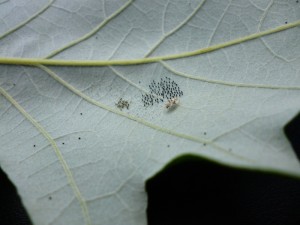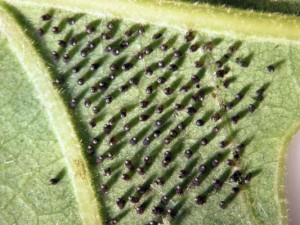During the weeks of summer, the symptoms caused by Oak Lace Bugs (Corythucha arcuata) can be a concern to some landscapers & nurserymen. Often times, the infestations are most pronounced on white oaks. From a distance, the stippling of leaves from this piecing-sucking insect can produce symptoms that are similar to those from oak spider mites or classic leaf scorch. Closer inspection determines the identity of the pest.
Although the leaf discoloration of the foliage caused by oak lace bugs can be alarming, spraying is generally not considered to be necessary. Tall landscape oaks would require large spray volumes of insecticides to achieve controls. Some exceptions can be argued for valuable trees in high visibility areas, but usually action is not required. This pest primarily creates an aesthetic concern. It is doubtful the insects have significantly reduced the tree’s ability to store starches & sugars during much of the summer. Infested trees are often able to perform adequate photosynthesis before symptoms become severe. The plant health damage to large oaks in the landscape is usually minimal.
Oak lace bugs & other species within the genus Corythucha feed on deciduous trees & overwinter as adults. Alternatively, lace bug species within the genus Stephanitis feed on broadleaf evergreens & overwinter as eggs. Distinguishing either genera from one another is relatively easy since adult lace bugs in the genus Corythucha have rectangular shaped wings, while species in the Stephanitis genus have wings that are oval shaped.
Interestingly, oak lace bugs have a egg laying pattern on leaf undersides that resemble a “miniature Stonehenge.” Look for a batch of 30 to 50 tiny black “spikes” arranged in a circular area of 3/4 inch diameter or less. These are sometimes incorrectly identified as excrement material, but actually are the eggs of this insect. Overwintering adult females begin laying eggs in late spring after the oak leaves have expanded. In NJ, there are typically 3 or 4 generations per year with the final generation eggs being laid in late summer.
The photograph below shows a variety of signs that can be identified on leaf undersides. These include fecal spots, eggs, the 5 instars of the nymphs, and adults. This information may be considered esoteric by some, but it can be of value to determine the size of future generations by observing eggs. Also if controls are desired, then targeting early nymph stages can enhance efficacy. As stated previously, often times the symptoms do not become prominent until later into the summer after 2 or 3 generations have been feeding. If a key oak tree in a key location is consistently infested every year, then treatments are best when provided early in the season. A systemic applied to the roots of large trees may require at least 2-3 months before the xylem can translocate the material sufficiently throughout the canopy.









